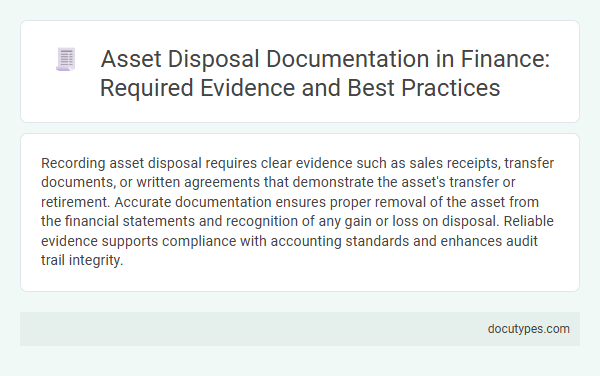Recording asset disposal requires clear evidence such as sales receipts, transfer documents, or written agreements that demonstrate the asset's transfer or retirement. Accurate documentation ensures proper removal of the asset from the financial statements and recognition of any gain or loss on disposal. Reliable evidence supports compliance with accounting standards and enhances audit trail integrity.
Introduction to Asset Disposal Documentation in Finance
Asset disposal documentation is a critical component in financial management, ensuring accurate records of asset removal from company books. Proper evidence for recording asset disposal includes disposal receipts, sale agreements, and removal authorizations, which validate the transaction's legitimacy. You must maintain these documents to support financial statements and meet regulatory compliance requirements.
Importance of Proper Asset Disposal Records
Accurate records of asset disposal are crucial for financial transparency and regulatory compliance. Proper documentation supports audit trails and helps prevent errors or fraud in financial reporting.
- Regulatory Compliance - Ensures adherence to legal and tax requirements related to asset removal.
- Financial Accuracy - Provides a clear account of asset write-offs affecting balance sheets and income statements.
- Audit Readiness - Facilitates efficient verification by auditors through detailed disposal records.
You enhance your organization's financial integrity by maintaining thorough and accurate asset disposal records.
Key Types of Asset Disposal in Financial Management
Recording asset disposal is crucial in financial management to ensure accurate reflection of a company's financial position. Evidence for asset disposal includes sales receipts, disposal agreements, or written authorization, which validate the removal of assets from the balance sheet.
Key types of asset disposal include sale, retirement, abandonment, and exchange, each with unique accounting treatment and documentation requirements. Your financial records must capture these transactions precisely to maintain compliance and provide clear audit trails.
Essential Evidence Required for Asset Disposal
Recording asset disposal requires precise and verifiable documentation to ensure accuracy and compliance in financial reporting. Essential evidence supports the legitimacy and details of the disposal process, safeguarding your financial records.
- Disposal Authorization - Official approval documents confirming the decision to dispose of the asset.
- Sales or Transfer Agreement - Legal contracts outlining the terms of asset sale or transfer to another party.
- Disposal Valuation Report - Appraisal or valuation evidence showing the asset's fair market value at disposal time.
Regulatory Compliance in Asset Disposal Documentation
Regulatory compliance is critical when recording asset disposal to ensure adherence to legal and financial reporting standards. Proper documentation provides evidence that disposals are conducted transparently and in line with jurisdictional requirements. You must maintain accurate records to support audits and avoid penalties related to incomplete or inaccurate asset disposal reporting.
Steps for Preparing Asset Disposal Documents
What is the evidence required for recording asset disposal? Proper documentation ensures the accurate tracking and verification of asset removal from financial records. This evidence includes disposal forms, approval signatures, and proof of sale or scrapping.
What are the essential steps for preparing asset disposal documents? First, identify the asset and gather all related financial and physical information. Next, complete disposal authorization forms, document the method of disposal, and obtain necessary management approvals.
Best Practices for Maintaining Audit-Ready Records
Recording asset disposal accurately is crucial for maintaining transparent financial records and ensuring compliance during audits. Best practices help you keep audit-ready documentation that supports asset value adjustments and disposal events.
- Consistent Documentation - Maintain detailed records including disposal date, method, approved authorizations, and asset condition to validate transactions.
- Proper Valuation and Removal - Update asset registers promptly by removing disposed assets at their net book value and recording any gains or losses correctly.
- Regular Reconciliation - Align physical asset counts with financial records frequently to detect discrepancies and support audit trails effectively.
Common Mistakes in Asset Disposal Documentation
Accurate recording of asset disposal is essential to maintain clear financial statements and comply with accounting standards. Common mistakes in documentation include incomplete records and failure to update asset registers promptly.
These errors can lead to misstated asset values and hinder audit processes. You must ensure all disposal details, such as date, sale proceeds, and approval, are thoroughly documented to avoid inconsistencies.
Leveraging Technology for Asset Disposal Tracking
| Aspect | Details |
|---|---|
| Importance of Recording Asset Disposal | Proper documentation of asset disposal ensures accurate financial reporting and compliance with accounting standards such as IFRS and GAAP. It prevents misstated asset values, supports audit trails, and maintains transparency in financial statements. |
| Common Evidence for Asset Disposal | Disposal records typically include sale agreements, disposal authorization forms, transaction receipts, and updated fixed asset registers. These documents validate the removal or sale of fixed assets from company books. |
| Role of Technology in Asset Disposal Tracking | Modern asset management software automates tracking through barcode scanning, RFID tags, and real-time database updates, reducing human errors and improving data accuracy. Integration with enterprise resource planning (ERP) systems enhances cross-departmental visibility. |
| Benefits of Leveraging Technology | Technology streamlines disposal workflows, accelerates audit preparation, and provides instant access to disposal history. Automated alerts ensure timely disposal recording, while analytics support decision-making regarding asset lifecycle management. |
| Examples of Technologies Used | Tools such as IBM Maximo, SAP Asset Manager, and Oracle E-Business Suite facilitate asset disposal tracking. Mobile applications enable field staff to update disposal events on-the-go, improving real-time accuracy. |
| Impact on Financial Controls | Technological tracking systems help enforce internal controls by restricting unauthorized disposal actions and maintaining a verifiable disposal trail. This reduces risks of asset misappropriation and financial misstatements. |
What Is the Evidence for Recording Asset Disposal? Infographic

